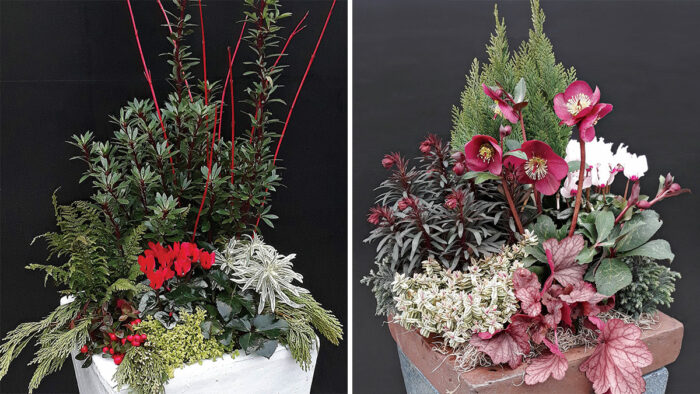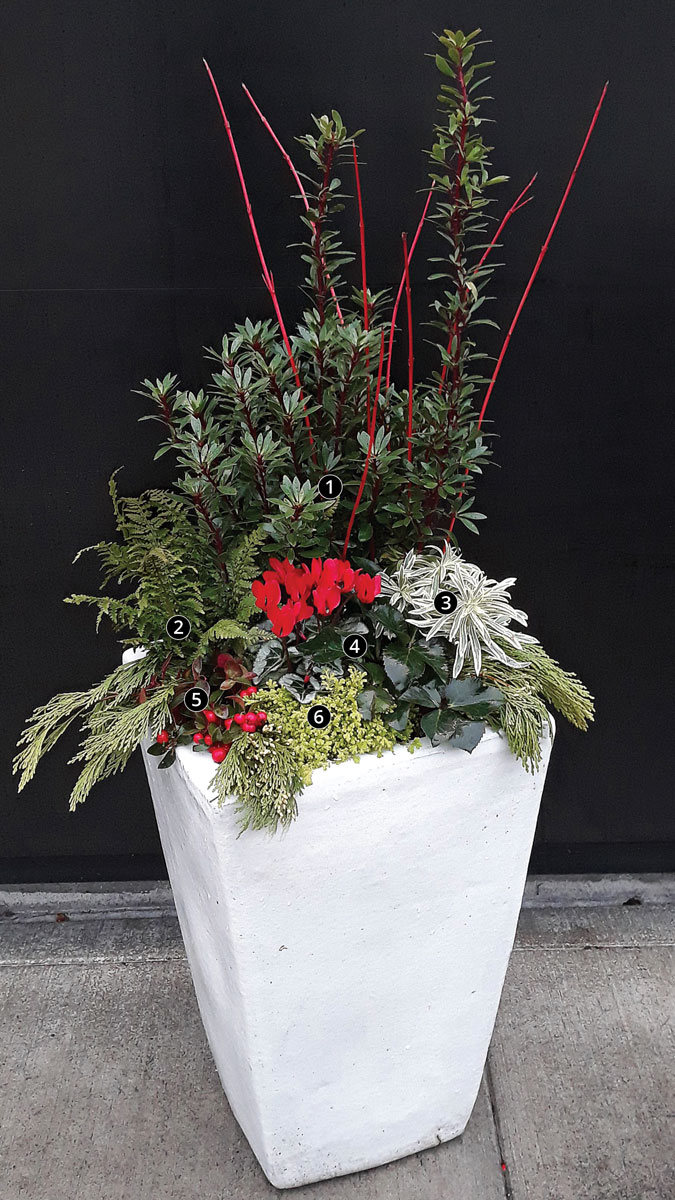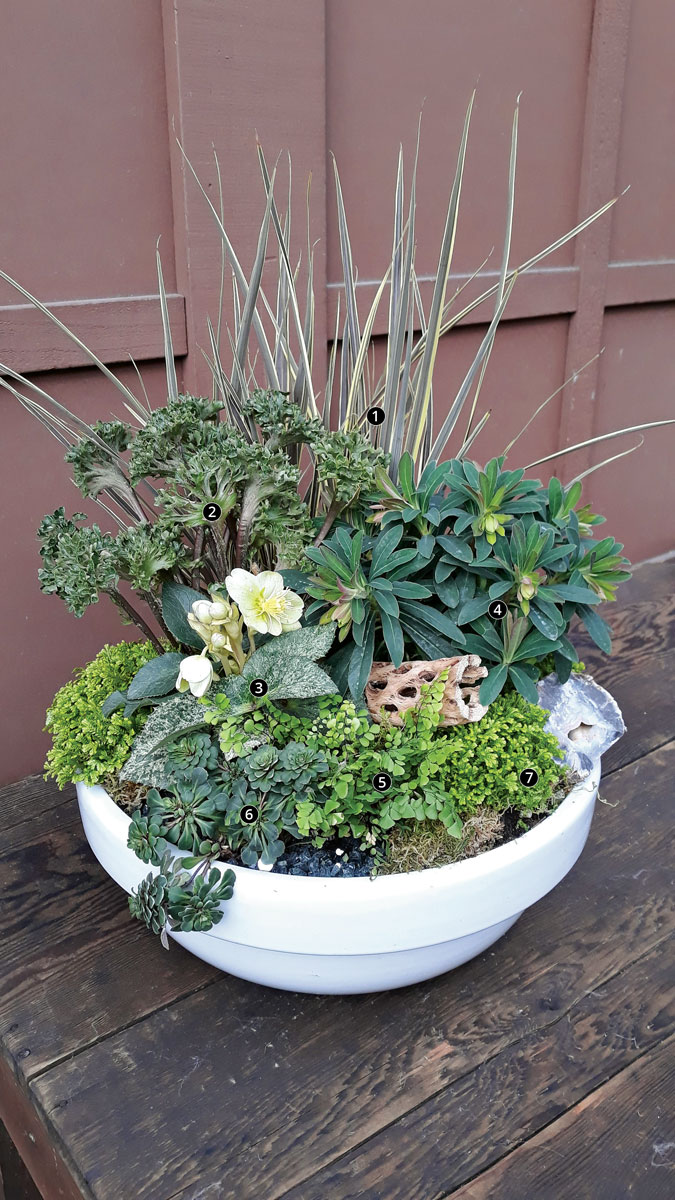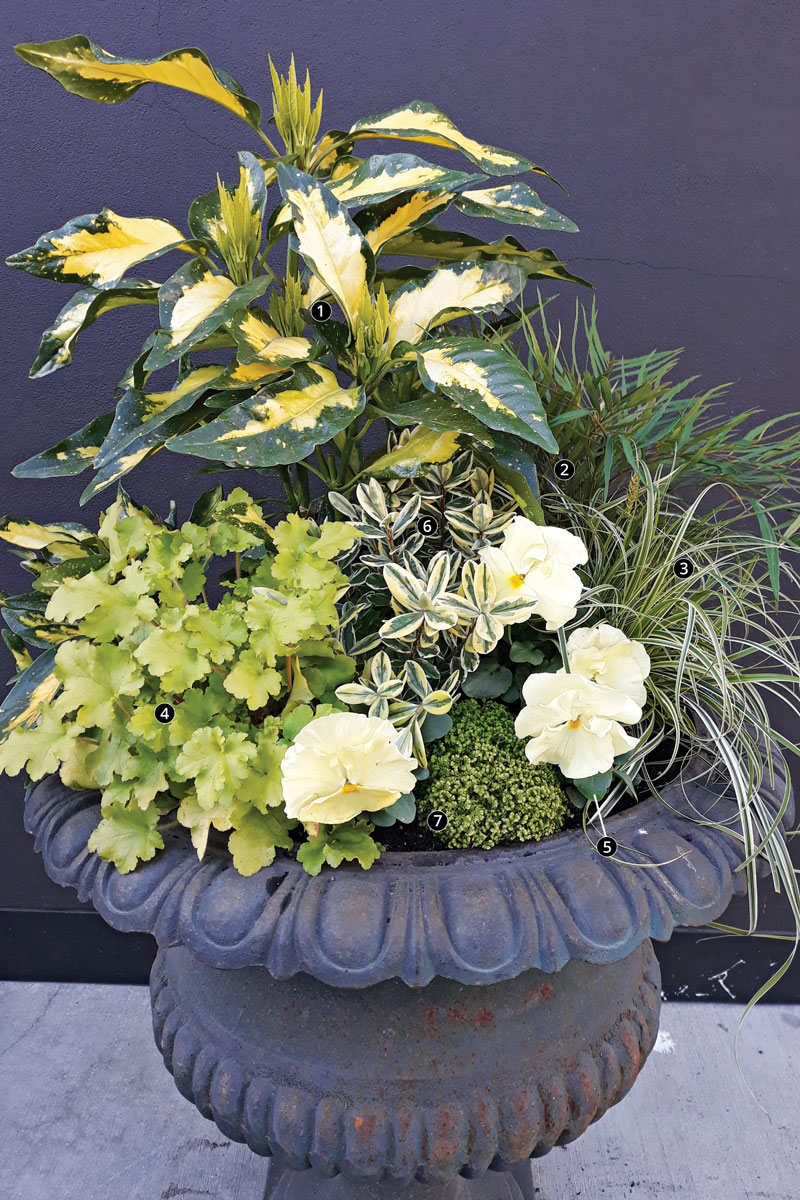Containers That Celebrate Fall and Winter
These durable, decorative plantings will carry you from mid-fall into the new year

As the growing season winds down and we put our gardens to bed, containers can be a creative playground going into fall and winter. The key to successful late-season containers is relying on tough evergreens with excellent foliage, mixed with winter bloomers for that floral hit we crave as the days shorten. Strategically placed evergreen cuttings and other natural materials can fill gaps left by the demise of summer annuals, or add a festive holiday vibe to an everyday container. Here are some examples of designs that extend the gardening season beyond the summer peak.
Lots of lacy texture

Anchoring a container with a strong evergreen vertical is a strategic move in any season. ‘Empire’ Lawson’s cypress is one of the most resilient, thriving even in cold weather and keeping a tight habit that lets the surrounding plants shine. Fine-textured heather and bold hellebore foliage provide continuity as they bloom in succession for a long hit of color. In mild climates, the hebe, heuchera, and ivy are four-season stars that give additional color to this combo even without blooms. The cyclamen brings a heady dose of short-term color. Natural additions, such as these pine cones and cut eucalyptus stems, can be used to add a festive feeling for the holidays, or to hide areas where summer plants have left a gap.
- ‘Empire’ Lawson’s cypress (Chamaecyparis lawsoniana ‘Empire’, Zones 5–9)
- ‘Anna’s Red’ hellebore (Helleborus ‘Anna’s Red’, Zones 5–8)
- ‘Silver Dollar’ hebe (Hebe ‘Silver Dollar’, Zones 7–9)
- ‘Tanja’ winter heath (Erica carnea ‘Tanja’, Zones 5–8)
- Success® Deep Magenta cyclamen (Cyclamen persicum cv., Zones 9–11)
- Forever® purple heuchera (Heuchera ‘TNHEUFP’, Zones 4–9)
- Variegated English ivy (Hedera helix* ‘Glacier’, Zones 4–9)
Added elements: cut eucalyptus, pine cone
*See invasive alert below.
Rich color echoes

Winter containers can also be a testing ground or temporary home for late-season acquisitions. Mountain pepper is a large shrub at home in the temperate garden. If, like many gardeners, you have succumbed to plant lust at the garden center late in the season, use a container to work out your combos before you dig. Here, American wintergreen and a red cyclamen provide a color echo to the red stems of mountain pepper, which can inspire a later pairing in the garden.
- Mountain pepper (Drimys lanceolata, Zones 8–10)
- Western sword fern (Polystichum munitum, Zones 6–8)
- Silver Swan euphorbia (Euphorbia characias ‘Wilcott’, Zones 8–10)
- Melody Outdoor® Red cyclamen (Cyclamen ‘Melody Red’, Zones 8–11)
- Wintergreen (Gaultheria procumbens, Zones 3–8)
- Golden spikemoss (Selaginella kraussiana ‘Aurea’, Zones 7–9)
Added elements: redtwig dogwood whips, incense cedar cuttings
Fanciful foliage

Not all containers need to be grand. This small bowl showcases some unusual foliage plants up close where they can be appreciated. It’s hard to limit yourself to subtle combinations of texture and form during the peak seasons when color is so enticing. But in the late seasons we are often ready for a limited palette, such as the one on display with these varied greens. Additional texture from crushed glass mulch, moss, cholla stems, and even geodes can add sculptural elements that don’t get lost in a gentle color scheme.
- ‘Electric Flash’ cordyline (Cordyline banksii ‘Electric Flash’, Zones 10–11)
- Shishi Botan’ leopard plant (Farfugium japonicum ‘Shishi Botan’, Zones 7–10)
- Snow Fever hellebore (Helleborus argutifolius ‘COSEH 900’, Zones 6–9)
- Martin’s euphorbia (Euphorbia × martinii, Zones 6–9)
- Himalayan maidenhair fern (Adiantum venustum, Zones 5–8)
- Dwarf London pride (Saxifraga ‘Primuloides’, Zones 7–10)
- Golden spikemoss (Selaginella kraussiana ‘Aurea’, Zones 7–9)
Added elements: glass mulch, cholla stem, natural geode, sheet moss
Sophisticated citrus notes

A dose of sunny lemon yellow is a welcome sight during any season, but pairing it with gray (dusty miller) and black (black mondo grass) makes a sophisticated, toned-down combination that is especially pleasing now. Choosing robust, cold-tolerant plants like the juniper, nandina, and mondo grass gives maximum longevity to a late-season planting while keeping a light and airy feel, even without the beautiful white blooms of the earliest hellebore (Helleborus niger).
- ‘Gold Cone’ juniper (Juniperus communis ‘Gold Cone’, Zones 5–7)
- ‘Lemon Lime’ heavenly bamboo (Nandina domestica* ‘Lemon-Lime’, Zones 6–9)
- Black mondo grass (Ophiopogon planiscapus ‘Nigrescens’, Zones 5–10)
- Jacob hellebore (Helleborus niger ‘HGC Jacob’, Zones 4–9)
- ‘Lime Marmalade’ heuchera (Heuchera ‘Lime Marmalade’, Zones 4–8)
- ‘Silverdust’ dusty miller (Senecio cineraria ‘Silverdust’, Zones 7–10)
- ‘Maculata’ vinca vine (Vinca major* ‘Maculata’, Zones 7–10)
*See invasive alert below.
Pretty patterns for shade

Shady gardens can still exhibit some late-season drama. Focusing on outstanding foliage plants, each with a different texture or form, keeps this urn lively and entertaining even when it has no blooms. In milder climates, every plant here will perform all winter long; by swapping out the annual pansies, the remaining plants will do so into spring and summer as well. ‘Soft Caress’ mahonia makes a wonderful companion to the bold-leaved spotted laurel, and it has the bonus of bright yellow flowers in late winter that are a critical source of food for overwintering hummingbirds.
- ‘Picturata’ spotted laurel (Aucuba japonica ‘Picturata’, Zones 7–9)
- ‘Soft Caress’ mahonia (Mahonia eurybracteata ‘Soft Caress’, Zones 7–9)
- ‘Feather Falls’ sedge (Carex oshimensis ‘Feather Falls’, Zones 5–9)
- ‘Lime Marmalade’ heuchera (Heuchera ‘Lime Marmalade’, Zones 4–8)
- Spring Matrix™ Primrose pansy (Viola × wittrockiana ‘PAS955441’, annual)
- Variegated hebe (Hebe speciosa ‘Variegata’, Zones 7–10)
- Pincushion spikemoss (Selaginella kraussiana ‘Brownii’, Zones 7–9)
A softer take on red and green

Fall and winter colors don’t have to be all fiery orange and Christmas red. A scheme of blues, dusty rose, and creamy white still feels like a late-season combo because the showiest plants, hellebore and cyclamen, are quintessential winter bloomers. Paying careful attention to color echoes is a perfect autumn and winter sport. Notice how the obvious hellebore color is repeated in the euphorbia and heuchera, and more subtly in the hebe and in the leaves and stems of the hellebore itself. Late-season containers allow us to slow down, relax, and enjoy the rewards of looking closely.
- ‘Empire’ Lawson’s cypress (Chamaecyparis lawsoniana ‘Empire’, Zones 5–9)
- ‘Anna’s Red’ hellebore (Helleborus ‘Anna’s Red’, Zones 5–8)
- ‘Silver Dollar’ hebe (Hebe ‘Silver Dollar’, Zones 7–9)
- Rocolina mix cyclamen (Cyclamen cv., Zones 8–11)
- ‘Georgia Peach’ heuchera (Heuchera ‘Georgia Peach’, Zones 4–9)
- Blackbird™ euphorbia (Euphorbia ‘Nothowlee’, Zones 6–9)
- ‘Blue Boulevard’ Sawara cypress (Chamaecyparis pisifera ‘Blue Boulevard’, Zones 4–8)
Added elements: dried Spanish moss as mulch
Tips for working with winter bloomers

Flowers add a welcome burst of color to cold-weather containers, so it is worth a little extra effort to keep them blooming for as long as possible. Nonhardy cyclamens (Cyclamen persicum cvs., Zones 8–11) are happiest when temperatures are 40° to 60°F. Although some can withstand a light frost, a dip below freezing is generally a death sentence. To get the most out of a cyclamen in an outdoor container, follow these steps:
- Tuck it into the container in its plastic grower’s pot, and keep it watered.
- During cold snaps, move the cyclamen to a cool, protected spot, such as a bright garage or an unheated room (photo). Bring it back out when temperatures climb above freezing. During minor temperature dips, keep the plant in place, protected with frost cloth or a paper bag.
- When temperatures drop to the low 30s and below, bring your cyclamen indoors to enjoy. It may bloom all winter in a cool area with bright light.
- Hellebores (Helleborus cvs., Zones 4–9) are very cold hardy, and their long winter bloom period can’t be beat.
- Leave the nodding, later-blooming types (Helleborus orientalis and cvs., Zones 6–9) for the garden.
- Choose from the many earlier-flowering hybrids, such as ‘Anna’s Red’, which have been bred for containers. These have stunning marbled foliage and more outward-facing flowers that will enhance a container design in all four seasons.
*Invasive alert: English ivy (Hedera helix)
This plant is considered invasive in AK, AL, AR, CA, GA, IN, KY, MD, NC, NJ, OR, PA, SC, TN, VA, WA, and WV.
*Invasive alert: Heavenly bamboo (Nandina domestica)
This plant is considered invasive in AL, FL, GA, MD, MO, and SC.
*Invasive alert: Periwinkle (Vinca major)
This plant is considered invasive in AL, AR, CA, GA, IN, and VA.
Please visit invasiveplantatlas.org for more information.
Barbara Libner is the head container designer and chief merchandiser at Ravenna Gardens in Seattle.






Comments
Really attractive winter container recipes! I review them every year when it's time to plant again. I think the recipes for the first and second pot are mixed up though - the first recipe describes the second container and the one for the second container is the recipe for the featured container by the title. Hope you continue to publish new ideas from Barbara Libner. I love her work!
Log in or create an account to post a comment.
Sign up Log in